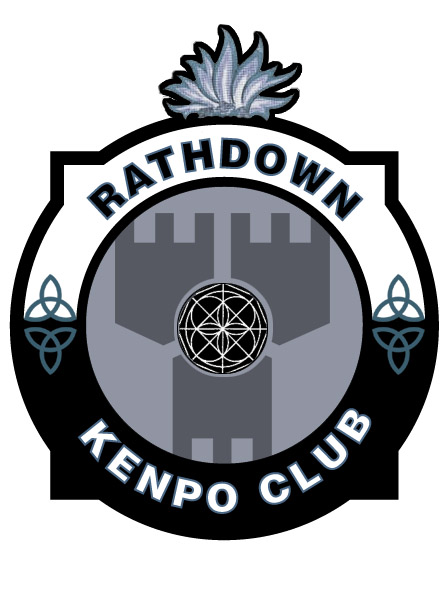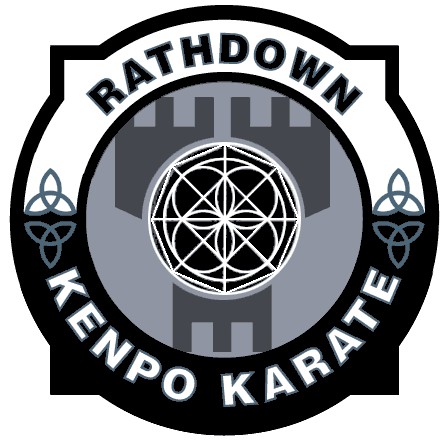


|
 |
Ed Parkers Kenpo Karate Crest, The Universal symbol and IKC Flame
 |
To be positioned on the upper right arm of suit
|
| Designed by Feargal Fitzpatrick, the Crest is based on the shape of a Celtic cross. The castles are taken from the Dublin emblem while we incorporated the Celtic knots to add an easily recognisable Irish aspect to the badge. The Universal pattern, one of the traditional emblems of Ed Parkers Kenpo was then included as the centrepiece, | |
![]()
|
The Tiger - Represents the earthly strength derived through the early stages of learning. This is the stage where the individual is more impressed with his own physical prowess. The Dragon - Represents spiritual strength which comes with seasoning. This mental attitude is attained during the individual's latter years of training. It is placed above earthly strength - as seen on the patch - since the individual at this stage has learned to develop humility and self-restraint. The Circle - This is symbolic of several things. It depicts life itself; a continuous cycle with no beginning or end just like the art of Kenpo which is also a cycle of unending and perpetual movement and motion. Techniques follow a cycle just as the various movements. Physical prowess, humility and self-restraint are no more than components of a progressive learning cycle. The circle is the base from which our alphabet stems; all moves evolve from a circle whether they are defensive or offensive. The circle also represents the bond of friendship that should continuously exist among association members. The Oriental writing - This is a reminder of the originators of the art - the Chinese. It offers respect to them but doesn't denote that we serve them. The Chinese characters on the right say 'Law of the Fist and Empty hand' while the writing on the left - 'Spirit of the Dragon and the Tiger' - are a constant reminder that we should strive to attain a spiritual level and that the physical level is only a stepping Stone or vehicle to reach a higher, spiritual level. The Dividing Lines - In the circle they represent the original 18 hand movements and directions in which the hands can travel. They are the angles from which you or an opponent can attack or defend, and they also form the pattern in which the feet can travel. The 'K' -This stands for Kenpo. The Colours - The white background is significant of the many beginners who form the base of the art. The yellow or orange represents the first level of proficiency - the mechanical, dangerous stage of learning. This is a time when the student it more impressed with the physical and thinks he knows all the answers. The circle is grey symbolising the brain, the brain of the association - remember that the brain it often referred to as 'grey matter'. The other colours represent proficiency, achievement and authority. Brown - the colour of the tiger's eyes - represent the advanced students though not great in number. Also at this level the student becomes more observant. His eyes, like that of the tiger, are keen and ever so watchful and critical, always looking up to the higher levels of proficiency; striving for perfection and preparing for the day he bears the label of 'expert'. This level of expert proficiency is represented by the colour black, while red is that of professorship over and above black belt. But yet, as indicated by the colours of the dragon, there are still traces white in the eyeball; yellow or orange on his fins; brown in the iris of the eyeball and black in the pupils. These colours are there to remind even the 'professor' that he should always be humble and able to return to any level. He should also be able to perform the things that he expects others at various levels to do and always be conscious of never demanding too much of his students. |
|
|
Universal Patch Excerpt from Infinite Insights into Kenpo Volume 4 - "The idea for the UNIVERSAL PATTERN was conceived by the flick of a switch. Because I was tired while viewing Karate techniques, instead of changing the reels on my movie projector, I decided to turn the reverse switch on instead. Studying myself on film was most beneficial. It was an excellent educational means to critique and improve my moves. this useful tool also allowed me to become more objective - to view myself through the eyes of an observer. Watching my movements in reverse changed my entire perspective of the Martial Arts. In fact, it fascinated me beyond my expectations. I was instantly aware that the natural forward motion viewed on the screen was only half of what motion really contains - motion in reverse completed the other half. I there upon discovered motion not only to be multi dimensional, but multi directional as well. I was, therefore, determined to design a pattern that would help me understand movement more thoroughly. I knew I had to have a directional key to movement - a design that would help aid students to systematically understand the interrelationship of linear and circular movement and the paths which they were to follow. Since both are unavoidably used in combat, they should be learned from a practical standpoint. Practicality, as we discussed, borders between simplicity and complexity."
|
I.K.K.A. Shoulder patch
This should be placed 1.5 cm below the shoulder and should be centred on the
left shoulder.
Universal Patch
This should be placed on the left side 1.5 cm below the I.K.K.A. shoulder
patch. This patch has many patterns. Prior to attaching it should be
positioned so that the shape of a heart is upright.
Personal Name
The personal name patch should be placed 2 cm above the large I.K.K.A patch
containing the dragon and tiger. The surname is used for brown and black
belts only. All other ranks use their first name on this patch.
I.K.K.A. patch
This should be placed on the left front side of the uniform
Flame patch
This should be placed on the right front side of the uniform. This patch
should be placed so that the flame is horizontally centred on the same level
as the Dragon on the I.K.K.A. patch.
Studio Name Patch
The name of the school/club should be placed 1.5 cm below the right shoulder and centred.
Home-Welcome-Faqs-Links-Overview-Timetable-KidsClass-Forum-Chat-Syllabus
Forms-Patches-Gallery-Freestyle-Guestbook